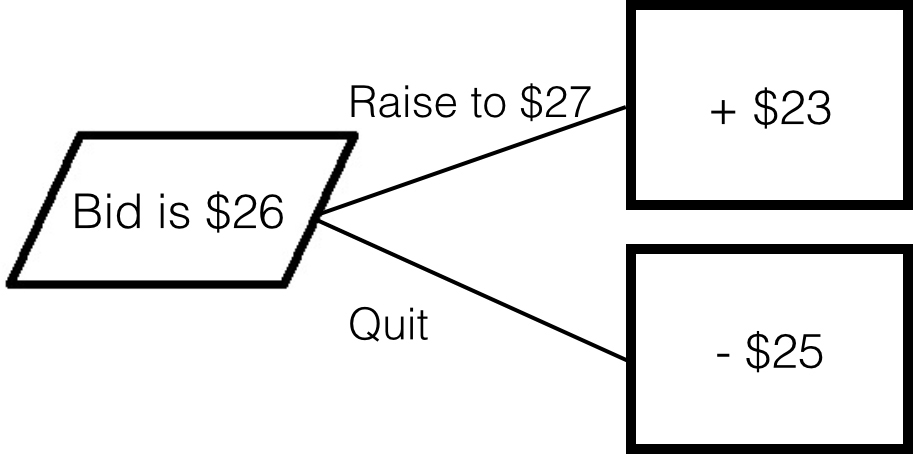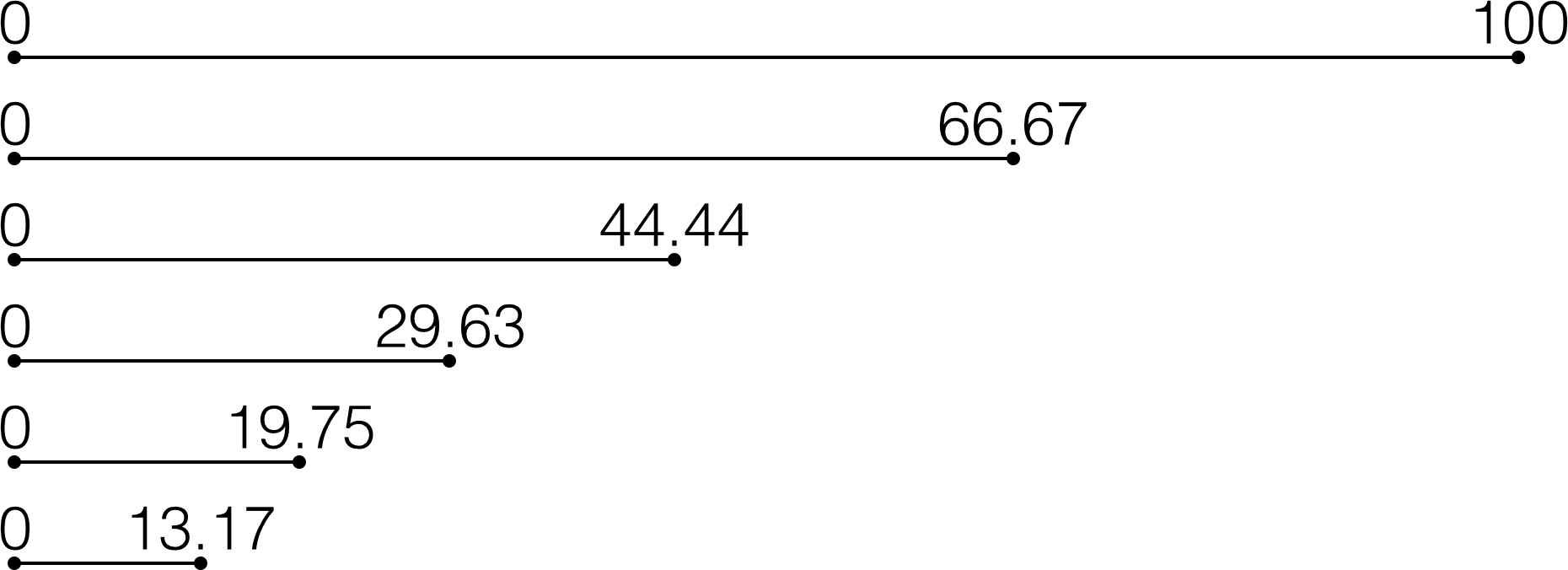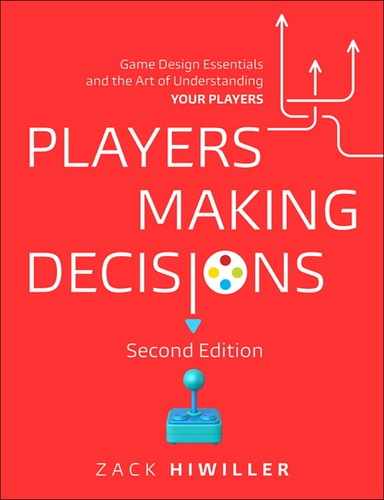21. Problems with Game Theory
Reality continues to ruin my life.
—BILL WATTERSON
Although game theory is interesting and provides a useful theoretical framework for what rational decision-makers should choose, it has its limitations when you’re dealing with real-world games. The first limitation is that examples in game theory tend to deal with highly idealized problems in which payouts are clear, information is shared, and complexity is mediated to a reasonable level. However, it’s difficult to transfer the knowledge from a good game theory problem to action inside a video game as complex as, for example, Halo.
However, even if you are able to perfectly model those textbook examples in your game’s decisions, you still have reasons to distrust the behavior patterns of human players that game theory predicts.
Rational Actors
The largest problem with applying game theory to real-world situations is the assumption that all players will act completely rationally.
Take this problem, for example:
A rebellion is rising. The revolutionaries want to bring the evil despot to justice. He is in one of his four castles, situated on a river flowing west to east through the capital city. The revolutionaries can get into one castle before the alarm is sounded and all the castles lock up tight. The despot knows they are coming and can get to the safety of any one of his castles. If they choose the correct castle, they will get the despot. If not, the revolution will fail. Castles 1, 3, and 4 are white. Castle 2, however, is painted a shining gold (Figure 21.1). Which castle should the revolutionaries storm?

CASTLE SYMBOL BY ANDRÉ RAFAEL, CASTLE SYMBOL BY BUENE BUENA, AND WATER SYMBOL BY ALESSANDRO SURACI, FROM THENOUNPROJECT.COM COLLECTION
Figure 21.1 Which castle should be stormed?
Game theory tells us that all the information about the castle colors, the information about the river, and even the position of the castles relative to each other is not relevant. To the despot, every castle is as good as any other as long as the revolutionaries do not pick it. To the revolutionaries, any castle is as good as any other as long as the despot is there. The equilibrium strategy predicts that both sides would choose each castle with a probability of 0.25. Thus, the despot would lose his head 25 percent of the time (Table 21.1).
Table 21.1 The Despot and the Revolution

In research that used actual human subjects, however, different results were seen.1 The expected 25 percent chose to hide in Castle 2. However, 40 percent chose Castle 3. The reasoning likely could have been that an interior palace was preferable, but the gold palace was too obvious. Yet none of those reasons were actual determining factors listed in the problem statement itself. Due to this imbalance, the despot loses his head 30 percent of the time instead of the expected 25 percent of the time if the despot had just chosen randomly.
1 Rubinstein, A. (2013, March 27). “How Game Theory Will Solve the Problems of the Euro Bloc and Stop Iranian Nukes.” Retrieved June 7, 2019 from www.faz.net/aktuell/feuilleton/debatten/game-theory-how-gametheory-will-solve-the-problems-of-the-euro-bloc-and-stop-iranian-nukes-12130407.html.
Human beings are remarkable pattern creators. From even before the time we first looked into the sky and shaped the stars into constellations, we practiced creating stories from data. It is not rational to see points of light in the sky whose sources are billions of miles apart and assign them the qualities of a crab or a bull. The players who choose Castle 3 may be doing the same thing; some may create a story from the problem explanation that biases them toward choosing that castle over any other.
Perhaps the differences between the experimental results and the theoretic prediction in the Despot and Revolution example in Table 21.1 are just random noise. Maybe over a longer run everything evens out to 25 percent across all four palaces. If that is the case, let’s use a different example that hits irrational players where they can feel it: in the wallet.
The Dollar Auction
Game theory sometimes relies on players being able to do difficult feats of math in real time. Earlier problems used induction to solve for the equilibrium. But do actual players use induction?
Imagine that I am going to auction off a $50 bill to a classroom full of students. There is no reserve price, so if the $50 bill goes for $1, so be it. The only catch is that both the winner and the next-highest bidder have to pay me their last bid at auction’s end. At the start, the students salivate over getting $50 for cheap, so they start bidding: $1, $2, $5. Soon the bidding is up to $25. Raising to $26 makes sense because the winner would still be up $24. Now look at the decision in Figure 21.2 for the person who has the $25 bid.

Figure 21.2 Deep into the dollar auction.
His choice is clear: He should raise the bid. But the person who was just raised faces the same problem. Once the bid is $27, she can choose to raise to $28 for a positive potential payoff or quit and lose her last bid. So she will raise. Once the bid is $50, a raise becomes the possibility of losing only $1 instead of losing $49. This, in theory, could go on forever, netting the auctioneer a tidy bit of money.
An inductive look at the problem shows that bidding is safe only when there can be cooperation. If all the bidders agree that one person will bid $1 and then share the proceeds, then the bidders can win. Otherwise, the auctioneer will bleed the participants dry. In an exercise that demonstrates this with business graduate students at a prestigious business school, the “winner” of the auction (a president of a company) paid $2000 for a $20 bill. The loser paid $1980 for nothing.2 Although inductive solving processes may make sense for isolated game theory examples, it’s questionable whether players use them in practice.
2 Murnighan, J. K. (2002). “A Very Extreme Case of the Dollar Auction.” Journal of Management Education, 26(1), 56–69.
The “Guess Two-Thirds” Game
Another game that shows the limitations of inductive thinking is the “guess two-thirds” game. In this game, a group is asked to have each member choose a number between 0 to 100 so that the person closest to two-thirds of the average of all submitted guesses wins a prize.
What should you choose? Some people assume that every number is as likely a guess as any other number. Under this reasoning, the average guess would be 50, so the two-thirds guess would be 33.33. Some take this a step further. If 33.33 is a likely guess, then two-thirds of that should be 22.22.
But why would every guess be as likely as any other? Should any player ever pick 100? 100 can win only if every single entry is also 100. In that case, two-thirds of the average would be 66.67, but everyone would be equally close to it. If you believed that to be the case, then you could choose any other number and be closer than everyone else.
No number above 66 and two-thirds can ever be two-thirds of the average because two-thirds of the highest possible guess average is 66 and two-thirds. If no number between 66.67 and 100 can ever be the correct answer, then why would anyone ever pick it? Players should reevaluate the problem as one in which the players are trying to get two-thirds of the average between 0 and 66.67. But if this is the case and no rational player would ever pick something above 66.67, then the same logic should hold for the range from 0 to 66.67. If everyone chooses 66.67, then two-thirds of the average is 44.44. Therefore, it’s not logical to pick any number above 44.44 because that can never be the right answer for rational players.
This logic repeats itself (Figure 21.3). If no number above 44.44 can ever be the right answer, then no player should pick a number above 44.44. If that is the case, then two-thirds of the average cannot be higher than 29.63. So a rational actor keeps iterating on this until the only rational choice is to choose 0. A group where everyone chooses 0 has a two-thirds average of 0. Everyone wins and no one has any reason to choose a different number.

Figure 21.3 Iterated solutions show a narrower and narrower range of rational possibilities.
Experimental results do not show players choosing 0 as a group, even though it is the rational game theoretical result. In one study that tested a similar game with the same expected result, the first time players played this game, not a single player chose 0.3 In another study, a plurality of players used the reasoning that treats every number as equally likely, resulting in a guess of 33.33, whereas a smaller group of players tried to exploit that likely guess by themselves guessing 22.22.4 Another study found the same clustering around these numbers while also noting that 10 percent of subjects chose a number that was impossible to be the two-thirds average (greater than 66.67).5
3 Duffy, J., & Nagel, R. (1997). “On the Robustness of Behaviour in Experimental ‘Beauty Contest’ Games.” The Economic Journal, 107(445), 1684–1700.
4 Rubinstein, A. (2007). “Instinctive and Cognitive Reasoning: A Study of Response Times.” The Economic Journal, 117(523), 1243–1259.
5 Nagel, R. (1995). “Unraveling in Guessing Games: An Experimental Study.” The American Economic Review, 1313–1326.
It’s clear that you cannot always trust real people to give a rational answer.
Second-Price Auctions
Perhaps in the previous examples, the game is just too complicated. What if people are rational up to the point that a problem becomes too complex, and then they give up and use poor heuristics? What if people realize the complexity of the dollar auction only after it is too late? What if you need players to act rationally in a game that does not require infinite iteration such as the “guess two-thirds” game? One example of a simpler common game in which players do not act rationally is the “second-price” auction, which I discussed in Chapter 16. You might be more familiar with the concept as similar to the auction system used by eBay.
In a second-price auction, participants (players) submit bids in secret for an item. The winner is, of course, the player who bid the highest. However, the winner pays only the amount of the second-highest bidder.
The concept of the second-price auction is popular because the equilibrium strategy is to bid exactly what you think the item is worth, and thus you cannot “outthink” or “bluff” the other players. No skill is required for a second-price auction. If you bid your actual value for the item, you have no reason to change to a different price. Let’s illustrate this with an example.
Say there is a second-price auction for a new pair of headphones. You value these headphones at $50, so you bid $50.
If you have the highest bid, do you have a reason to change your bid if you are allowed to? Say that the second-place bid is $40. If you do nothing, you profit $10—the value of the headphones to you minus what you have to pay. Should you increase your bid? If you increase the bid, you still value the headphones at $50 and still only pay $40—you have the same amount of profit, so you have no reason to do this. Should you decrease your bid? If you decrease it to somewhere in the $40.01–$49.99 range, then this also has no change—you value the headphones at $50 and get them for $40, gaining $10 in profit. If you lower your bid below $40.01, then you do not win the headphones but you also don’t pay anything. This is a $0 profit. Since that is less than the $10 you would get for not changing your bid, there is no reason to change your bid if you are winning.
If you do not have the highest bid, do you have a reason to change your bid? Say that you are the second-place bid at $50 and the winner bid $59.99. If you do nothing, you profit $0. If you lower your bid, you still lose and so still profit $0. If you raise your bid up to $59.98, you still lose and still profit $0. However, if you raise your bid to $60, you win the auction but end up paying $60 for a pair of headphones you only value at $50. You end up with a profit of –$10. Thus, even if you are losing, you have no reason to change your bid beyond the maximum you value the item.
Note
An argument can be made that sniping software exists to restrict the flow of information from competitors who do not know their true willingness to pay.
If you have ever used eBay, however, you have likely seen or been party to some irrational decision-making. One study compared the value of items on eBay auctions to the Buy It Now price for that same item.6 In the study of one particular item, 42 percent of auctions exceeded the initial Buy It Now price. Another study showed that 98.8 percent of eBay prices for media such as books or CDs are higher than the lowest online price found in a 10-minute search.7 Additionally, in a second-price auction, it makes no sense to ever update your bid based on what the other players have done. Nothing in the previous strategy mentioned when a player should bid. Yet in one study of 240 eBay auctions, 89 had bids placed in the final 60 seconds of a multi-day auction.8 A variety of providers sell “sniping” software that allows a user to increase their bid at the last possible moment.
6 Malmendier, U., & Lee, Y. H. (2011). The bidder’s curse. The American Economic Review, 749-787.
7 Ariely, D., & Simonson, I. (2003). “Buying, Bidding, Playing, or Competing? Value Assessment and Decision Dynamics in Online Auctions.” Journal of Consumer Psychology, 13(1), 113–123.
8 Roth, A. E., & Ockenfels, A. (2002). “Last Minute Bidding and the Rules for Ending Second Price Auctions: Evidence from eBay and Amazon Auctions on the Internet.” American Economic Review, 92(4), 1093–1103.
With these examples, it is difficult to justify using game theory alone to determine what players will do when engaged in a game.
Summary
• Game theory provides tools for predicting the behavior of rational players. Unfortunately, the rational player is more of a theoretical construct. Actual player behavior can diverge from the theoretical results.
• Players may be influenced by irrelevant information that has no bearing on their likelihood of success.
• Induction is often not used by real-world players, especially in situations with many iterations of the induction loop.
• Although auctions can provide a way to dig out a player’s willingness to pay, auction behavior is not always rational.
• Game theory is a good starting point for beginning to understand player behavior, but it cannot be the only tool you use.
